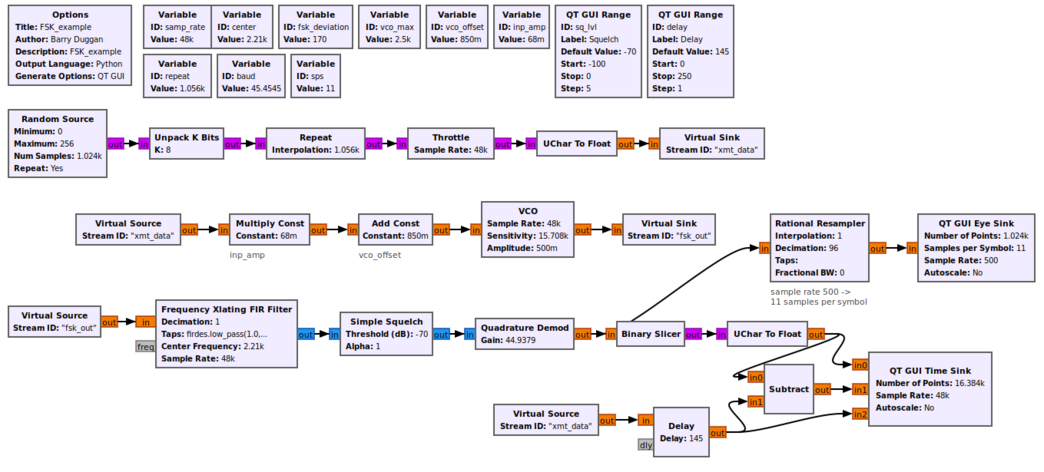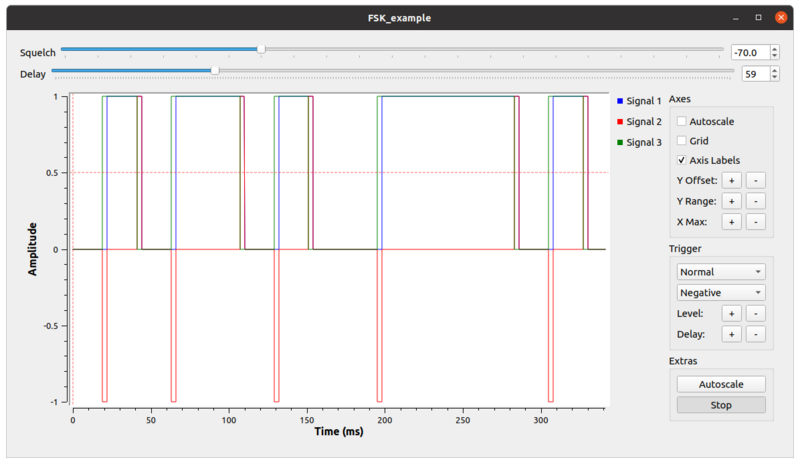Simulation example: FSK: Difference between revisions
| Line 1: | Line 1: | ||
<!-- Simulation_example:_FSK.mediawiki --> | <!-- Simulation_example:_FSK.mediawiki --> | ||
<!-- Simulation_example:_FSK.mediawiki --> | |||
<b>Under construction!</b> | <b>Under construction!</b> | ||
This tutorial can be performed with either | GNU Radio (GR) is an excellent tool for simulating a radio system and experimenting with changing parameters. This tutorial presents a simple Frequency Shift Keying (FSK) transmitter and receiver. It can be performed with either GR version 3.7 or 3.8 (and later). The Graphical User Interface gnuradio-companion (GRC) is used to create the flowgraph. No special hardware is required. | ||
== Prerequisites == | == Prerequisites == | ||
| Line 11: | Line 10: | ||
* [[Sample_Rate_Tutorial|'''Understanding sample rate''']] | * [[Sample_Rate_Tutorial|'''Understanding sample rate''']] | ||
== | == Simulating a transmitter and receiver == | ||
Using gnuradio-companion (GRC) and the following Block descriptions, build this flowgraph:<br> | Using gnuradio-companion (GRC) and the following Block descriptions, build this flowgraph:<br> | ||
[[File:FSK_example_fg.png|800px]] | [[File:FSK_example_fg.png|1044px]] | ||
=== Setting variables and parameters === | |||
Most of the parameters can be set from the screenshot of the flowgraph. | |||
* The Options block identifies the filename for the flowgraph, a title, author, etc. | |||
** id: FSK_example | |||
** Click on File -> Save As Use the file name 'FSK_example'. the extension '.grc' is added automatically | |||
For this tutorial I am using the baud rate for Baudot Radioteletype. It is defined as a bit time of 22 milliseconds, so the baud rate is set to 1/0.022 giving 45.4545 | |||
The repeat factor is (int)(samp_rate*0.022) | |||
=== Description of data flow === | |||
== Testing == | |||
[[File:FSK_example_out.png|800px]] | |||
== Further study == | |||
Revision as of 15:03, 9 September 2020
Under construction!
GNU Radio (GR) is an excellent tool for simulating a radio system and experimenting with changing parameters. This tutorial presents a simple Frequency Shift Keying (FSK) transmitter and receiver. It can be performed with either GR version 3.7 or 3.8 (and later). The Graphical User Interface gnuradio-companion (GRC) is used to create the flowgraph. No special hardware is required.
Prerequisites
Simulating a transmitter and receiver
Using gnuradio-companion (GRC) and the following Block descriptions, build this flowgraph:
Setting variables and parameters
Most of the parameters can be set from the screenshot of the flowgraph.
- The Options block identifies the filename for the flowgraph, a title, author, etc.
- id: FSK_example
- Click on File -> Save As Use the file name 'FSK_example'. the extension '.grc' is added automatically
For this tutorial I am using the baud rate for Baudot Radioteletype. It is defined as a bit time of 22 milliseconds, so the baud rate is set to 1/0.022 giving 45.4545
The repeat factor is (int)(samp_rate*0.022)

